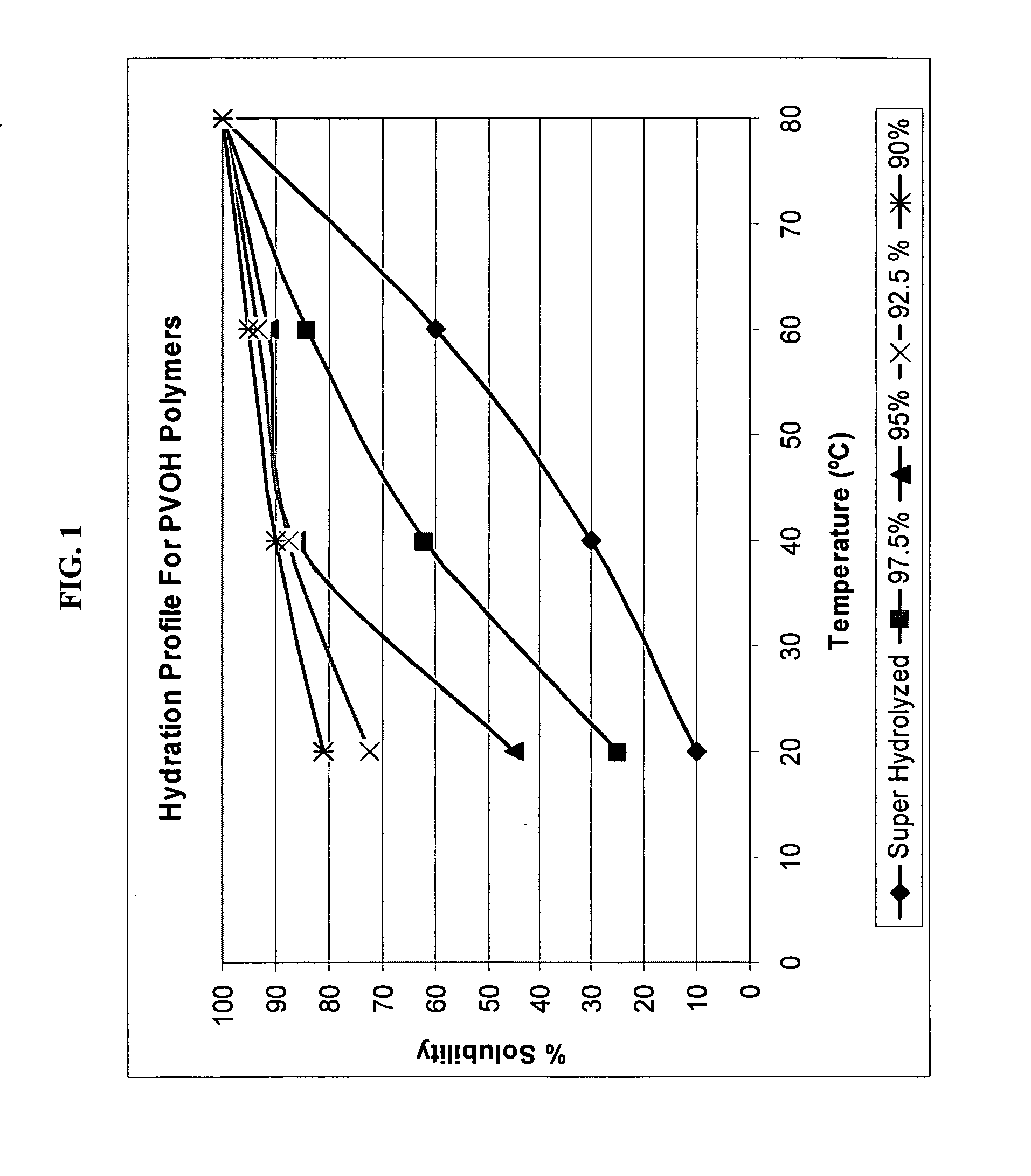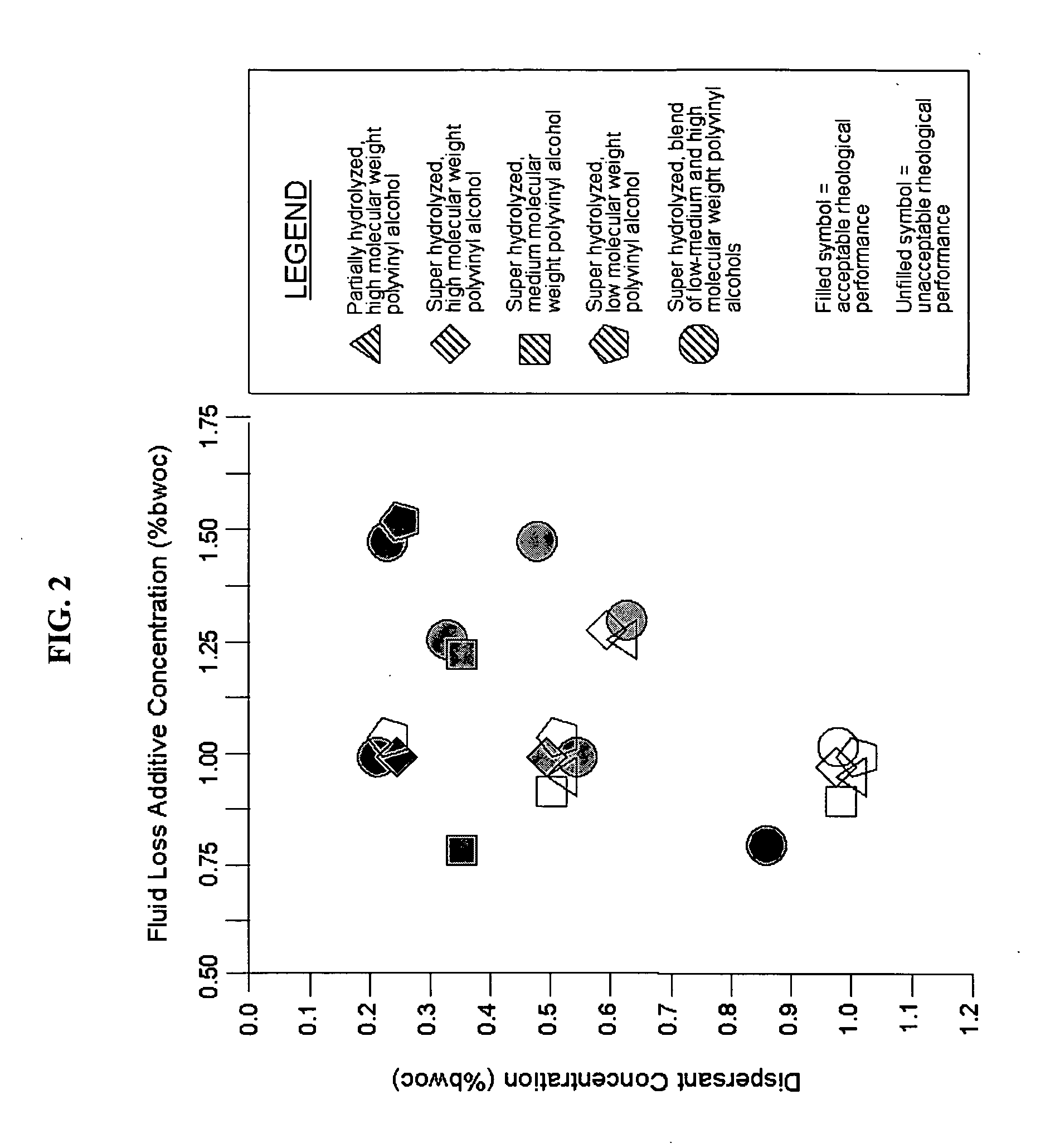Fluid loss additive with improved rheological properties
a technology of additives and additives, applied in the field of formulating cement with fluid loss additives, can solve the problems of fluid loss in insufficient thermal stability of cross-linked pvoh, and loss of filtrate from cement slurry into porous low pressure zones, etc., to achieve the effect of reducing fluid loss
- Summary
- Abstract
- Description
- Claims
- Application Information
AI Technical Summary
Benefits of technology
Problems solved by technology
Method used
Image
Examples
examples 1-4
[0077]In examples 1-4 below, Celvol 125S (super hydrolyzed, c.v. 28-32, 80 mesh particle size) and Celvol 165S (super hydrolyzed, c.v. 62-72, 80 mesh particle size) were measured for solubility at surface conditions (20° C.) and at down hole conditions (90° C.) at various stirring times according to the following procedure.
[0078]A hotplate is set at the reported temperature conditions (20° C. or 90° C.) with a magnetic stir bar spinning at 250 rpm inside a 200 ml beaker filled with 96 ml DI water. The water is allowed to equilibrate to the test temperature. The beaker has an agitator inside which is set at variable, but steady speeds of 150 rpm to 450 rpm. 4 g of Celvol sample is added to the DI water. Time is started at the beginning of sample addition, which takes one minute.
[0079]Once added, a 0.2 ml sample was taken with a disposable pipette at t=1, 2, 3, 5, 10, 15, 20, 30, 45, and 60 minutes. The sample was placed on the prism of a VEE GEE refractometer (range from 1.3330-1.409...
example 5
[0082]The most commonly used polyvinyl alcohol based fluid loss additive known in the industry is based on a partially hydrolyzed, high molecular weight polymer with a characteristic viscosity of approximately 50 cP. Typical cement slurries make use of approximately 0.75% bwoc polymer in combination with approximately 0.25% bwoc dispersant. This combination results in acceptable rheologies and fluid loss values up to temperature of approximately 150° F. (65° C.).
[0083]In order to attain higher temperature performance, it is common practice to increase the loading of polymer. For the partially hydrolyzed, high molecular weight PVOH, increased loading tends to upgrade the temperature resistance to provide for acceptable fluid loss properties. Unfortunately, it also tends to result in a very thick slurry with poor rheology. The rheological readings and fluid loss properties of a slurry that is prepared with 1.0% bwoc of a partially hydrolyzed, high molecular weight polymer and 0.5% bwo...
example 6
[0085]For exemplary purposes, the partially hydrolyzed, high molecular weight polyvinyl alcohol resin used in Example 5 was combined with dispersant at slightly different concentrations in an effort to better disperse the cement and improve rheology. Here the polyvinyl alcohol was included at 1.00% bwoc and the dispersant level was 1.00% bwoc. The rheological readings and fluid loss properties are shown below.
Visc. @Visc. @Visc. @Visc. @Visc. @Visc. @Visc. @PVYPTemp.300 rpm200 rpm100 rpm60 rpm30 rpm6 rpm3 rpm(cP)(lb / 100 ft2) 80° F.300300184114601210174126194° F.15810249301542164−6Test Temp.(° F.)ResultAPI Fluid Loss (ml / 30-min)19416Free Fluid (%)19438
[0086]For the combination of 1.00% bwoc partially hydrolyzed, high molecular weight polymer and 1.00% bwoc dispersant shown above, the rheological readings again indicate a very thick, yet unstable slurry as evidenced by the high YP at 80° F., the low YP at 190° F., and the sudden drops in viscosity from the 30 rpm to the 6 rpm readings...
PUM
| Property | Measurement | Unit |
|---|---|---|
| Temperature | aaaaa | aaaaa |
| Temperature | aaaaa | aaaaa |
| Temperature | aaaaa | aaaaa |
Abstract
Description
Claims
Application Information
 Login to View More
Login to View More - Generate Ideas
- Intellectual Property
- Life Sciences
- Materials
- Tech Scout
- Unparalleled Data Quality
- Higher Quality Content
- 60% Fewer Hallucinations
Browse by: Latest US Patents, China's latest patents, Technical Efficacy Thesaurus, Application Domain, Technology Topic, Popular Technical Reports.
© 2025 PatSnap. All rights reserved.Legal|Privacy policy|Modern Slavery Act Transparency Statement|Sitemap|About US| Contact US: help@patsnap.com



